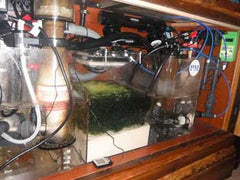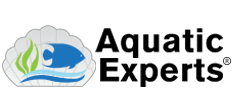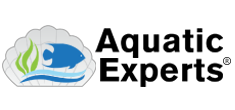
High levels of nitrates and phosphates have frustrated many a saltwater hobbyist. Now refugiums are here to save the day! A refugium uses macro algae, mud and/or sand as natural filters for reducing nitrates, silicates, and phosphates. As you harvest (remove) macroalgae you are also removing excess nutrients from the aquarium. Reducing excess organic nutrients helps control unwanted algae growth in the display aquarium. Since a refugium is generally separate from the main aquarium it provides protection for copepods and amphipods, giving your aquarium a constant, natural food source. This natural food can be netted from the refugium or will travel naturally to the display aquarium via the lines connecting the two. Predators such as fish, shrimp, and corals should never be placed in your refugium.
Refugiums come in a variety of styles including hang-on, internal, stand-alone and built-in. A hang-on refugium consists of an acrylic box with baffles, a powerhead to pump water from the aquarium into the refugium, and a light. The water flows through the refugium and gravity feeds it back to the aquarium. Just add mud or sand and macro algae and it is ready to go.
Choose a refugium style based on your budget and the amount of room you have. Once one is chosen and plumbed to your display aquarium it is ready to set up. Add mud and/or an oolithic (sugar size) aragonite sand to a depth of up to six inches; add live rock and macro algae.
The following macro algae do well in refugiums: Chaetomorpha, Ulva (Sea Lettuce), halymenia (red seaweed) and Gracilaria (red seaweed). These macro algae remove nitrates and phosphates from aquarium water. Regular trimming and thinning of these plants removes the nutrients out from the aquarium.
Place a light over the refugium to grow macro algae. The bulb should be 5,000 to 6,500 Kelvin for optimum plant growth. Choose a light fixture that produces at least 4 watts per gallon of water in the refugium (for those less than 16 inches deep).
The Refugium Light Goes On When The Display Light Goes Out.
To stabilize the pH and oxygen levels the refugium lights should be set to turn on at times opposite the display aquarium. During the day plants and algae in the display aquarium use up carbon dioxide and give off oxygen when exposed to light. When the display aquarium light is off photosynthesis no longer takes place and CO2 levels rise. Carbon Dioxide (CO2) when it mixes with water is an acid, so pH lowers at night when the light is out. With a refugium light on while the display aquarium lights are off algae in the refugium will use CO2 and produce Oxygen, keeping the pH in the entire system stable.





